Globalization seems to homogenize the world as technology dissolves the barriers of time and space. The proliferation of international actors and links appears to eat away at the very foundations of the Westphalian state system. Where the global meets the local is at the walls that define the external objective boundaries of political units and the internal subjective identities of their citizens.
Media Walls
As walls dissolve, they also spread. Walls have spread physically with the globalizing architecture of the modern world; and they have spread virtually through the proliferation of wall signs, symbols, and images. They are vertical exclamations interrupting the horizontal flow of space. Walls are the thin hard shells of cities and nations. In the modern world, moreover, walls no longer only sit on the physical ground but occupy cyberspace as well.
Walls thus appear where one might think them least likely, in the broadcasts of news media with global aspirations. Two networks—CNN and BBC have created news broadcasts that aspire to a global, rather than a regional, national, or local audience. More recently Aljazeera has launched an English language television news program. All three networks either broadcast in English or wish to do so and have created websites that shadow their regular television programming. As part of an ongoing research program on globalizing media, we captured these websites for brief sampling periods in July and November 2004 and more comprehensively for all of 2005. We recorded at regular midnight intervals and then searched the resulting files for walls.
Modern media carry images of and references to walls. Many of the discrete references are figures of speech. The BBC sample, for example, includes the following figurative phrases: backs against the wall, chest wall, crater wall, mark on the wall, torn down walls, wall of silence, wall-to-wall, and writing on the wall. Wall Street gets quite a lot of play. Talk about the interplay of signifiers—a street named for a wall that refers to the American financial community. But there are also many physical walls in the news broadcasts. The walls are often destroyed in natural or human catastrophes like earthquakes, floods, or warfare.
We may think of these as private walls, important to their owners but without wider public significance. Beyond these private walls stand public walls with political significance as they enclose and separate larger political communities. Such walls gratify some and offend others. Historical public walls include the Great Wall of China and the Berlin wall. The Israeli-Palestinian wall and US-Mexican wall are more contemporary.
Consistent with their global aspirations, each of the news networks carries reports about each of these walls. Yet, each network also reflects its own individual identity giving each of the walls a different significance in its reports.
Dead Walls
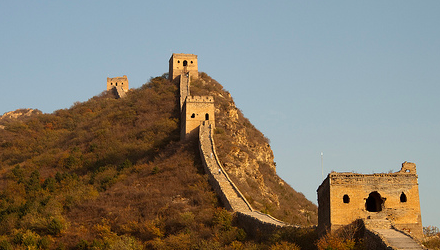
Some walls are mainly sites of historical memory. These dead walls, like dead metaphors whose origins are long forgotten, are the exoskeleton remains of disappeared cities and empires. These are walls like the Great Wall of China and the Berlin Wall.
The most magnificent is certainly the Great Wall of China. On September 12 2005, CNN carried a story on “China: Hiking the Great Wall.” The caption to one of the photos said that “adventurous travelers can explore and even camp put in watchtowers along the Great Wall of China.” The state as museum meets global adventure travel.
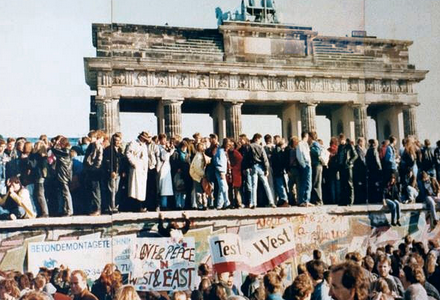
When walls stay up that is one kind of memory. Another kind of wall memory is when they come down. Sometimes the something that does not love a wall achieves its total destruction. So, for example, on October 3, 2005, BBC News World Edition marked the 15th anniversary of the fall of the Berlin Wall with pictures of young people celebrating. One picture showed young people celebrating near the wall in 1990.
An earlier story, on November 9, 2004 had shown young people dancing at the Brandenburg gate.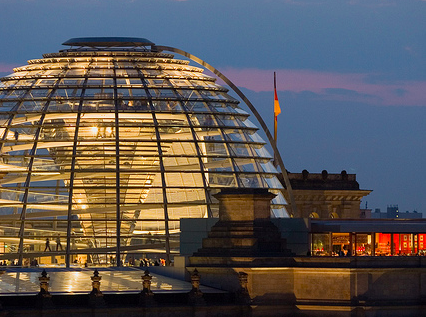 The same story juxtaposed the stone wall of an older building, with a German flag on top, with the steel and glass wall of a new structure.
The same story juxtaposed the stone wall of an older building, with a German flag on top, with the steel and glass wall of a new structure.
The Berlin Wall is an icon of historical memory, but it is much more. The BBC News website, a globalizing medium with British roots, tells a story of new Germany joyfully rising from a dark past. Moving away from the walls of the Cold War, it shows young people and modern technology asserting their coming of age. The story appears uncontroversial, an interesting scene of renewal and growth appropriate for media aiming at a multi-national global audience.
Yet, one wonders how this triumphal tone appeals to Russians, who lost tens of millions of people fighting against the Germans within the memory of many still alive.
Living Walls
Living walls are still being created. Some of these, like those that memorialize the Holocaust, may look toward the past and seek to preserve its memory. Other walls mark contested territorial boundaries.
Holocaust Walls
A BBC story of January 23, 2005 carried the headline “Holocaust memorial opens in Paris.” The photo here is very different from the ones above. Instead of young people gaily celebrating and the marvels of modern technology, the photo showed older people pointing at the wall. The caption reads “most of the victims died in the Nazi death camp at Auschwitz.” One wonders how this sample of the older Jewish demographic in the globalizing media’s audience felt about the earlier festivities of German youth and the dynamic of German modernization.
The Israeli Wall
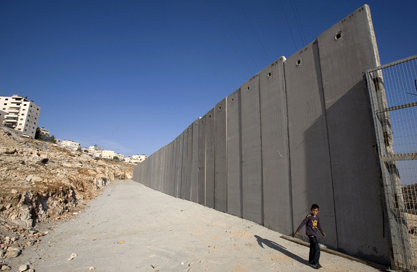
Of the three news networks, Aljazeera gave the most attention to the wall being built by the Israelis to separate themselves from the Palestinians. Though Aljazeera has ambitions as a global news network, the flood of text and images about the Israeli wall makes it clear that it Aljazeera’s heart is in the Middle East, and on one side of the wall. As with the Berlin Wall, media images show the younger generation seeking to transcend the wall.
Aljazeera stories on its websites of March 14 and August 14, 2005 show children walking with their mother a child walking near the wall. Captions on the photos say that “Palestinians say the wall is absorbing some of their lands” and that “the wall makes it almost impossible for children to get to schools.” Another photo, from July 10, 2005, shows a young couple getting married. The caption is “Palestinians have reacted furiously to the Israeli plan.”
A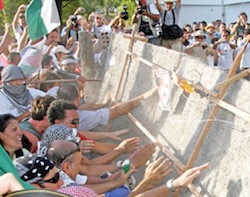 ll is not sweetness and light. On June 5, 2005, the photo to the left showed “protesters pulling down a wall in a symbolic protest in Bait Sarik.”
ll is not sweetness and light. On June 5, 2005, the photo to the left showed “protesters pulling down a wall in a symbolic protest in Bait Sarik.”
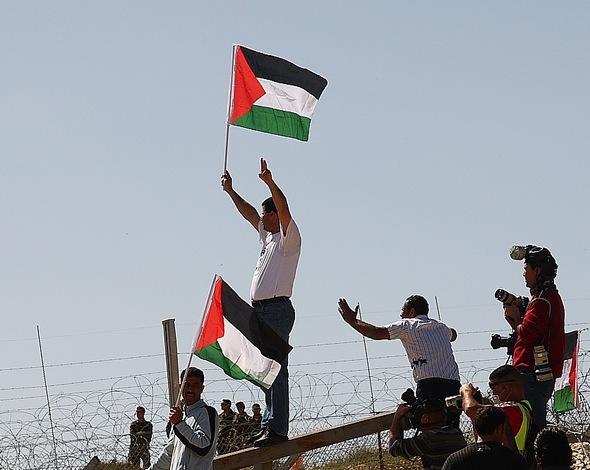
On July 11, the Aljazeera caption again said that “Palestinians have reacted angrily to the Israeli plan.” The Palestinian protester’s sign “Apartheid Wall” added punch to the image as it linked their struggle that of the South Africans.
Young people carrying the Palestinian flag appear on the wall on February 23. In the caption, “Palestinians say the wall blocks them from having a viable state.” And on October 6, the image of young people, the flag, and the wall combine with the caption “Palestinian residents of Jerusalem are being walled out of the city.”
On July 26, 2004, there are also young people wrapped in an Israeli flag, but they do not appear to be near the wall. The Aljazeera caption says that “Sharon’s disengagement plan is seen by some as just a US pleaser.”
Embassy Walls
CNN ran fewer stories on the Berlin wall than BBC and on the Israel wall than Aljazeera. One might have expected similar stories on the Mexican wall, but it was too early. There was, however an interesting story about North Koreans seeking asylum in Embassies on January 23, 2005. The caption said that “in September a large group scaled the wall around the Canadian Embassy in Beijing.” Young people climbing walls redux.
Mythical Walls
 Walls, as we have suggested, are not only physical structures but also mythical ones that define liminality, uniting and dividing political communities. In borderlands, walls mark the edges of different communities. They set off different worlds of meaning, separating self and other, “us” and “them.” Sometimes they mark the margins of the clash of civilizations.
Walls, as we have suggested, are not only physical structures but also mythical ones that define liminality, uniting and dividing political communities. In borderlands, walls mark the edges of different communities. They set off different worlds of meaning, separating self and other, “us” and “them.” Sometimes they mark the margins of the clash of civilizations.
Wall stories are embedded in reports of globalizing news networks. In these media stories, different walls do different things. Each wall has its own story. Such walls as the Great Wall of China and the Berlin Wall are sites of memory, markers of past histories different from the present and from each other. Contemporary walls and fences between Israel and the Palestinians, the United States and Mexico are less sedimented. They mark currently contested sites; frontier borders where separate political communities flow together. These walls require constant physical mending. Natural and human forces want to bring them down and turn them into walls of memory.
Wall stories tell of the creation and the destruction. They condense the memories and myths of those who are walled in and those who are walled out, the offense and the defense, those who give offense and those who receive it.
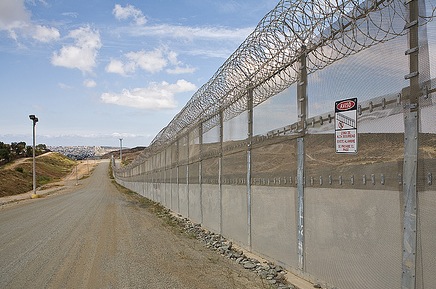 As globalizing media tell wall stories, they give the walls legitimacy and power. Wall stories imply that the walls are important news. Wall stories reflect and construct an important part of the myths–the dominant narratives– of past history, present events, and the prospective future of globalizing culture. Aiming at a global audience, globalizing media should tell particular kinds of war stories. They should not report from one side or another of the walls. They should be on both sides of the walls, with a style that appears fair and balanced. At the same time, the globalizing media do not just report the facts. They also interpret, and their stories inevitably come from a particular perspective. The soil of the roots flavors the wine from the vines. The BBC reporting colors the Berlin Wall in dark colors that may not quite suit the taste of some Russians with long memories. Aljazeera’s depiction of the Israeli wall is not designed to appeal to Jews. Each network appeals to a segment of the global audience, but not the whole.
As globalizing media tell wall stories, they give the walls legitimacy and power. Wall stories imply that the walls are important news. Wall stories reflect and construct an important part of the myths–the dominant narratives– of past history, present events, and the prospective future of globalizing culture. Aiming at a global audience, globalizing media should tell particular kinds of war stories. They should not report from one side or another of the walls. They should be on both sides of the walls, with a style that appears fair and balanced. At the same time, the globalizing media do not just report the facts. They also interpret, and their stories inevitably come from a particular perspective. The soil of the roots flavors the wine from the vines. The BBC reporting colors the Berlin Wall in dark colors that may not quite suit the taste of some Russians with long memories. Aljazeera’s depiction of the Israeli wall is not designed to appeal to Jews. Each network appeals to a segment of the global audience, but not the whole.
Wall stories memorialize the past and show the present becoming the future. Some try to tear them down; President Ronald Reagan calls on Chairman Gorbachev to tear down the Berlin Wall. Some try to evade them, for example Mexican immigrants at the southern border of the United States. Others try to build them up. The walls in the news stories are metaphors of community and division. They mix geography and history. They carry material and mythical meanings for the societies on either side, as well as beyond, and for emerging global culture.
—
Francis A. Beer is Professor Emeritus of Political Science at the University of Colorado, Boulder. His personal blog is Mythic America.
G. Robert Boynton is Professor of Political Science at the University of Iowa, Iowa City. His personal blog is Globalizing News.
References
Beer, Francis A. and G. Robert Boynton. 2009. Globalizing Media and International News. Iowa City IA: University of Iowa http://inpress.lib.uiowa.edu/globalizingcommunication/
Brown, Wendy. 2010. Walled States, Waning Sovereignty. Cambridge MA and Brooklyn NY. Zone Books.
Burgess, J. Peter. 1994. “European Borders: History of Space/Space of History”. http://www.ctheory.net/articles.aspx?id=55
Jones, Reece. 2012. Border Walls: Security and the War on Terror in the United States, India, and Israel. London and New York: Zed Books.
Lesham, Noam. 2012. “Beyond the Wall: Writing Conflict and History in Jerusalem”. (November 10). http://www.e-ir.info/2012/11/10/beyond-the-wall-writing-conflict-and-history-in-jerusalem/
Loyd, Jenna M., Matt Mitchelson, and Andrew Burridge, eds. 2012. Beyond Walls and Cages: Prisons, Borders, and Global Crisis. University of Georgia Press. Athens, Georgia.
Pegasus. nd. Research on Place and Space: Borders, Edges, Liminality, Marginality. University of Central Florida, Orlando. http://pegasus.cc.ucf.edu/~janzb/place/borders
Sasikumar, Karthika. 2012. “Review–Border Walls”. http://www.e-ir.info/2012/08/01/review-border-walls/
Vale, Peter. 2009. Understanding the fall of the wall and other time tales. (June 1). http://www.e-ir.info/2009/06/01/understanding-the-fall-of-the-wall-and-other-time-tales/
Images by: matt512, Lear 21, Reichstag, visitBerlin, Wall in Palestine, ygurvitz, and waynewhuang.
Further Reading on E-International Relations
- State of Exception? When Theory Meets Its Walls: A Rejoinder
- Opinion – Confronting Israel’s Annexation Plans: From Fear to Hope
- Opinion – The Complexities of Establishing Who Killed Shireen Abu Aqla
- Opinion – The Silencing of Amnesty International’s Report on Israeli Apartheid
- Opinion – Discriminatory Ice Cream?
- Opinion – Israel-Palestine Policy Under Biden